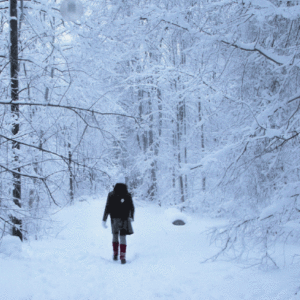
Residents and visitors of the Eagle River Valley are fortunate to have trailheads leading into the Eagles Nest & Holy Cross Wilderness Areas at our doorsteps. Winter, with far fewer folks on the trails, is a truly special time to ski or snowshoe into the Wilderness. Here are a few easy tips for keeping your Wilderness impact to a minimum, while ensuring you have an amazing winter experience.
What is Wilderness? A 2019 Town of Vail survey of hikers in the Eagles Nest Wilderness revealed that many folks didn’t even realize they were in Wilderness or know what Wilderness is. The 1964 Wilderness Act defines Wilderness as “an area where the earth and its community of life are untrammeled by man, where man himself is a visitor who does not remain.” Wilderness is intended to provide “outstanding opportunities for solitude.”
Be informed: Check the trail regulations before you go, and read signage at the trailhead. For instance, all trails into the Eagles Nest Wilderness require dogs to be on a hand-held leash year-round and at all times, even while hiking, skiing, or camping – these include Bighorn, Booth, Gore, and Pitkin trails. And bikes aren’t allowed – so reserve your fat-tire bike for non-Wilderness trails.
Safety First: Even if your activity doesn’t travel through known avalanche terrain, consider equipping yourself with avalanche training (there are some good free online courses) and be sure to check the Colorado Avalanche Information Center for daily avalanche conditions. Many wilderness trails in the Vail area, including the Bighorn, Booth Creek and other East Vail Trails, travel through avalanche terrain.
Be prepared: Throw some warm layers in your backpack, since you may be cold or wet on the descent or need to stop for repairs or a snack. While it’s safer to travel with a buddy, always tell someone where you are going and when you expect to return, and advise them if you change routes. Keep in mind that there’s not always a cell signal, and batteries won’t last as long when cold. And in winter it’s unlikely someone will just “happen by” in the event you need help.
On-trail travel: Whenever possible, staying on-trail is less impactful to the environment. Wear traction for icy or muddy trails, so you don’t create “new” trails. Use snowshoes or skis for deep snow - postholes create dangerous conditions for other users and wildlife. Keep in mind that trails on north-facing slopes have more snow and will clear later in the spring.
“Doo” the right thing: There’s nothing like a quick spring melt to reveal the layers of unpleasantness left by careless winter travelers. Pick up after yourself and your dog, and carry your bags with you – they can easily be covered by snow and not re-emerge until spring. It’s a common misconception that dog and human waste is the same as wildlife waste, but it actually presents a health hazard for wildlife and people, taking longer to break down, polluting streams and lakes, and transmitting harmful parasites and diseases. And try to pee off trail, and cover that yellow snow.
Wildlife: One of the great joys of winter Wilderness travel is seeing wildlife, including elk, deer, bighorn sheep, foxes, lynx, ptarmigans, and porcupines. But remember that winter is a stressful season for our wild neighbors, who are searching for scarce food sources while trying to conserve energy, and who also may be pregnant or caring for young. For your and their safety, keep your distance.
Your Dog in Wilderness: It is an incredible privilege to share the Wilderness with our pups. But remember that the dog-on-leash rule doesn’t take a winter vacation. Leashing your dog protects wildlife and other visitors’ Wilderness experience, and improves chances of seeing wildlife and their tracks. A leash helps protect your dog from wildlife, and you from wildlife your dog may disturb. Even if your dog doesn’t chase wildlife, wildlife is aware of your dog, and will move away, reducing habitat in which to feed, breed, and rest. Dog scent affects wildlife long after dogs are gone—another good reason not to let your dog off trail. Repeated stress suppresses immune systems, increases wildlife’s vulnerability to disease and parasites, and reduces reproduction and growth.
Mask up: With fewer people on our winter trails, it may feel like Covid has taken a break – but we still need to remember to pull up our masks when keeping a 6-foot distance isn’t possible, which is on almost all of our narrow Wilderness trails!
One last thing: Have fun! With these few precautions, you can have an amazing adventure, while still treading lightly. Together, let’s Keep Wilderness Wild!
About the Eagle Summit Wilderness Alliance
The Eagle Summit Wilderness Alliance is a volunteer led 501 c3 nonprofit organization committed to keeping wilderness wild in Eagle & Summit Counties. ESWA assists the US Forest service in maintaining the Holy Cross, Eagles Nest, and Ptarmigan Wilderness areas.
Frances Hartogh is a volunteer with the Eagle Summit Wilderness Alliance
Hike with Walking Mountains!
If you are interested in exploring your local backcountry trails with a guide, or learning more about the wildlife (and how to track them) or snow science of our valley, join Walking Mountains Science Center for half day snow shoe tours in the White River National Forest each Tuesday and Thursday. Programs include tracking programs and snow science hikes. For more information and to register visit www.walkingmountains.org/snowshoe.







